Strategic Human Resource Management (SHRM) Report: Business Strategy
VerifiedAdded on 2020/12/24
|13
|4213
|297
Report
AI Summary
This report provides a comprehensive analysis of Strategic Human Resource Management (SHRM), exploring its critical link to business strategy, vertical alignment, horizontal integration, and various SHRM models. It critically evaluates specific HR practices, including performance management and reward systems, offering recommendations for their design and redesign to support organizational development and change. The report also delves into the nature and theoretical perspectives of employment relations, examining the roles of actors within the employment relationship and the changing dynamics of employment. Furthermore, it offers recommendations on how employee participation and employee voice can improve employment relations. The report concludes with key findings and recommendations to enhance SHRM practices and foster positive employee relations, drawing upon relevant academic literature and industry examples to support its arguments.
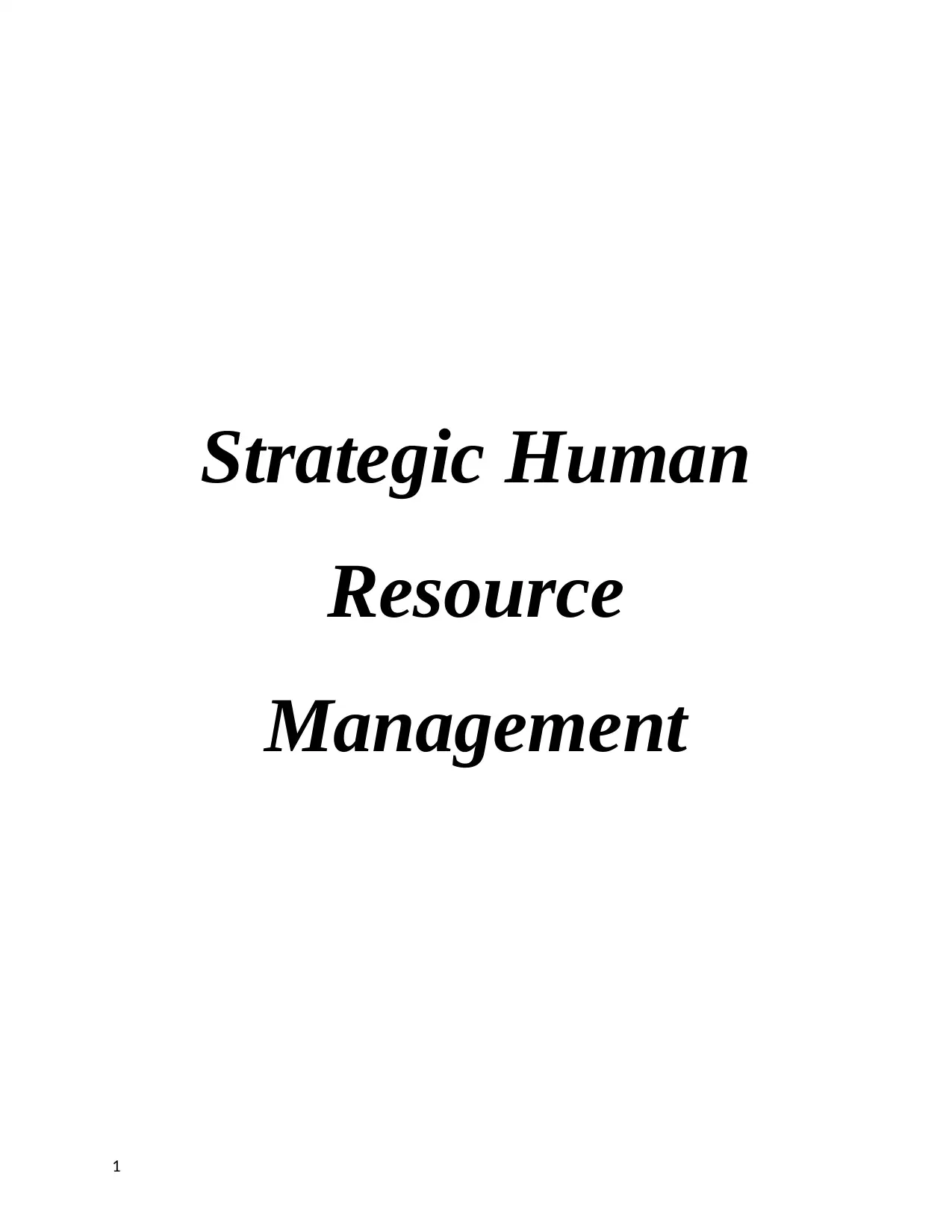
Strategic Human
Resource
Management
1
Resource
Management
1
Paraphrase This Document
Need a fresh take? Get an instant paraphrase of this document with our AI Paraphraser
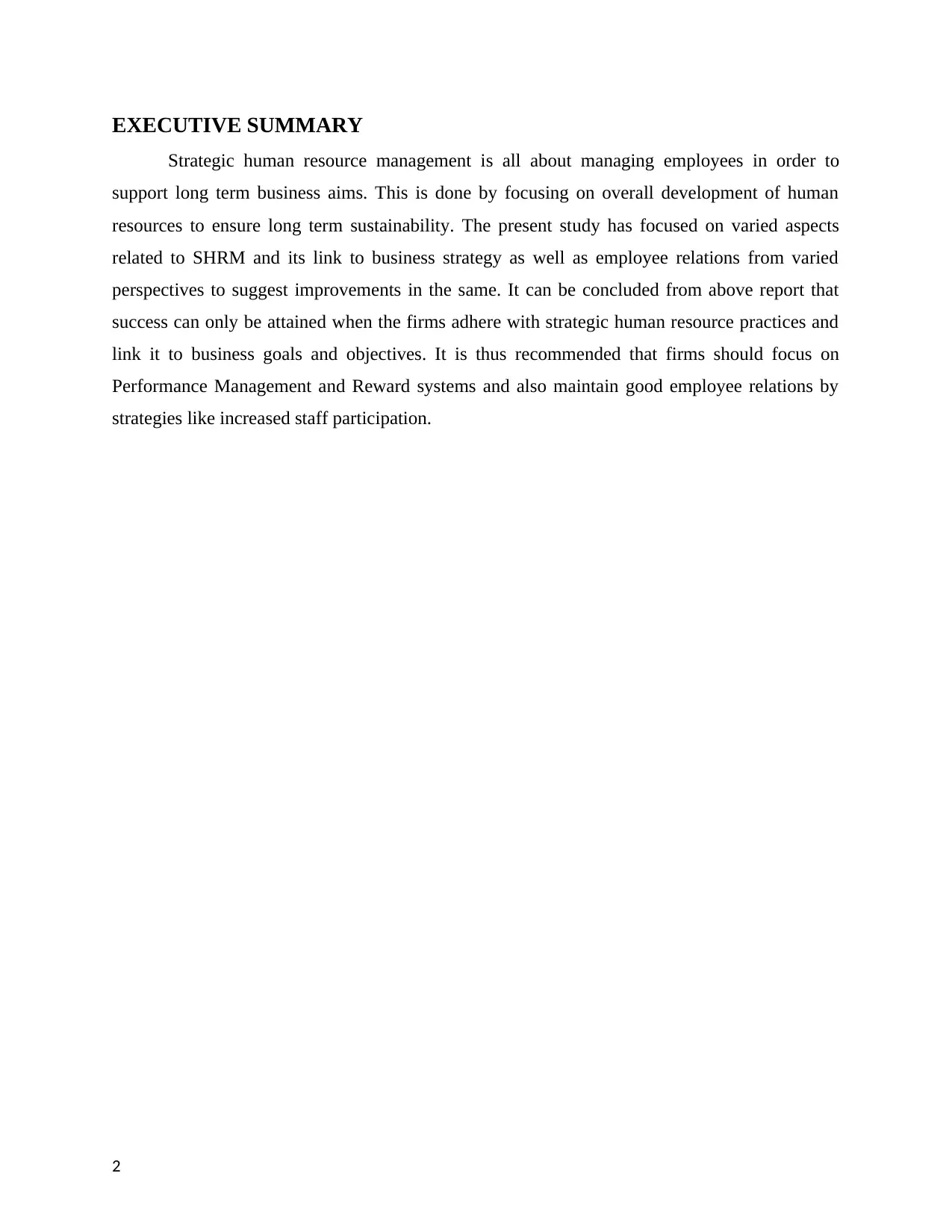
EXECUTIVE SUMMARY
Strategic human resource management is all about managing employees in order to
support long term business aims. This is done by focusing on overall development of human
resources to ensure long term sustainability. The present study has focused on varied aspects
related to SHRM and its link to business strategy as well as employee relations from varied
perspectives to suggest improvements in the same. It can be concluded from above report that
success can only be attained when the firms adhere with strategic human resource practices and
link it to business goals and objectives. It is thus recommended that firms should focus on
Performance Management and Reward systems and also maintain good employee relations by
strategies like increased staff participation.
2
Strategic human resource management is all about managing employees in order to
support long term business aims. This is done by focusing on overall development of human
resources to ensure long term sustainability. The present study has focused on varied aspects
related to SHRM and its link to business strategy as well as employee relations from varied
perspectives to suggest improvements in the same. It can be concluded from above report that
success can only be attained when the firms adhere with strategic human resource practices and
link it to business goals and objectives. It is thus recommended that firms should focus on
Performance Management and Reward systems and also maintain good employee relations by
strategies like increased staff participation.
2
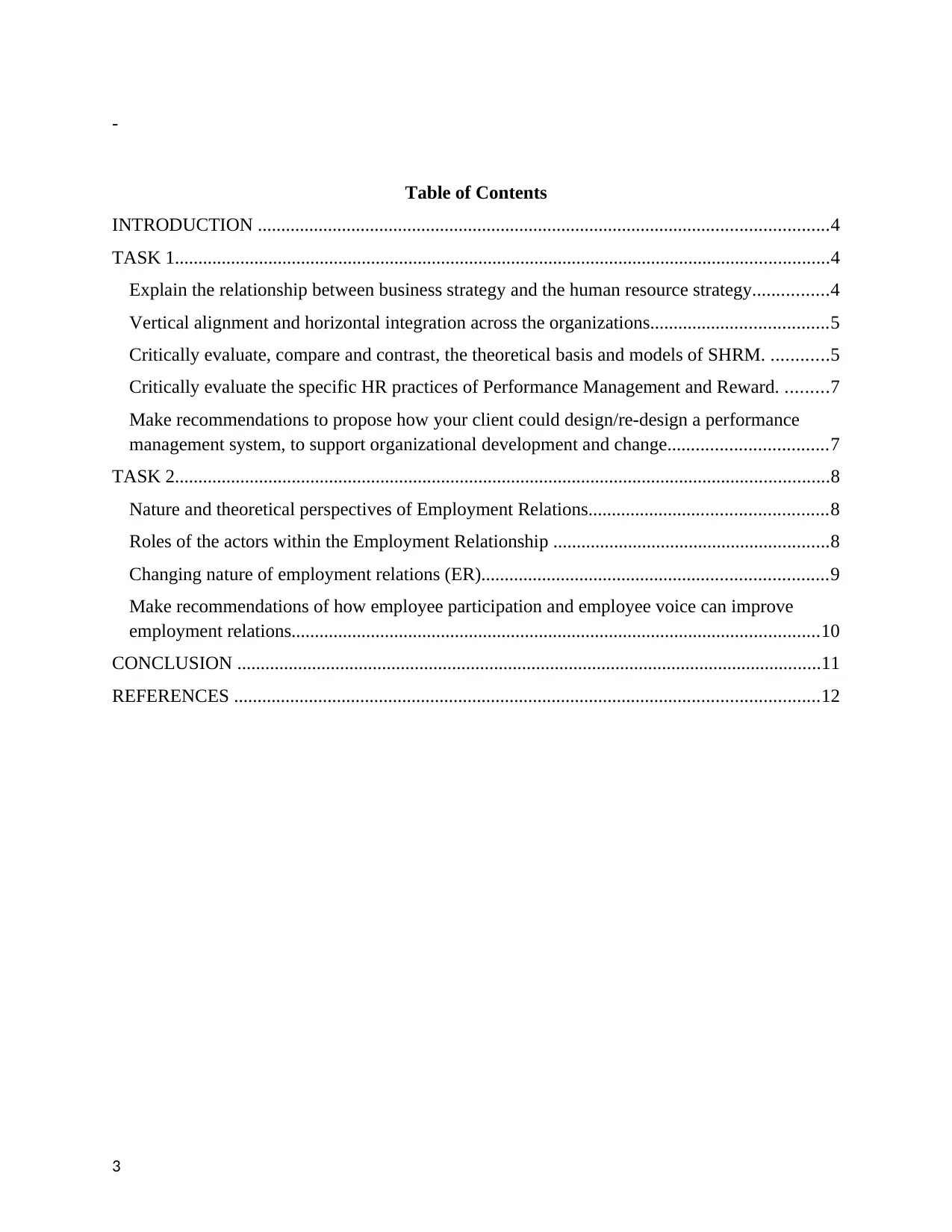
-
Table of Contents
INTRODUCTION ..........................................................................................................................4
TASK 1............................................................................................................................................4
Explain the relationship between business strategy and the human resource strategy................4
Vertical alignment and horizontal integration across the organizations......................................5
Critically evaluate, compare and contrast, the theoretical basis and models of SHRM. ............5
Critically evaluate the specific HR practices of Performance Management and Reward. .........7
Make recommendations to propose how your client could design/re-design a performance
management system, to support organizational development and change..................................7
TASK 2............................................................................................................................................8
Nature and theoretical perspectives of Employment Relations...................................................8
Roles of the actors within the Employment Relationship ...........................................................8
Changing nature of employment relations (ER)..........................................................................9
Make recommendations of how employee participation and employee voice can improve
employment relations.................................................................................................................10
CONCLUSION .............................................................................................................................11
REFERENCES .............................................................................................................................12
3
Table of Contents
INTRODUCTION ..........................................................................................................................4
TASK 1............................................................................................................................................4
Explain the relationship between business strategy and the human resource strategy................4
Vertical alignment and horizontal integration across the organizations......................................5
Critically evaluate, compare and contrast, the theoretical basis and models of SHRM. ............5
Critically evaluate the specific HR practices of Performance Management and Reward. .........7
Make recommendations to propose how your client could design/re-design a performance
management system, to support organizational development and change..................................7
TASK 2............................................................................................................................................8
Nature and theoretical perspectives of Employment Relations...................................................8
Roles of the actors within the Employment Relationship ...........................................................8
Changing nature of employment relations (ER)..........................................................................9
Make recommendations of how employee participation and employee voice can improve
employment relations.................................................................................................................10
CONCLUSION .............................................................................................................................11
REFERENCES .............................................................................................................................12
3
⊘ This is a preview!⊘
Do you want full access?
Subscribe today to unlock all pages.

Trusted by 1+ million students worldwide
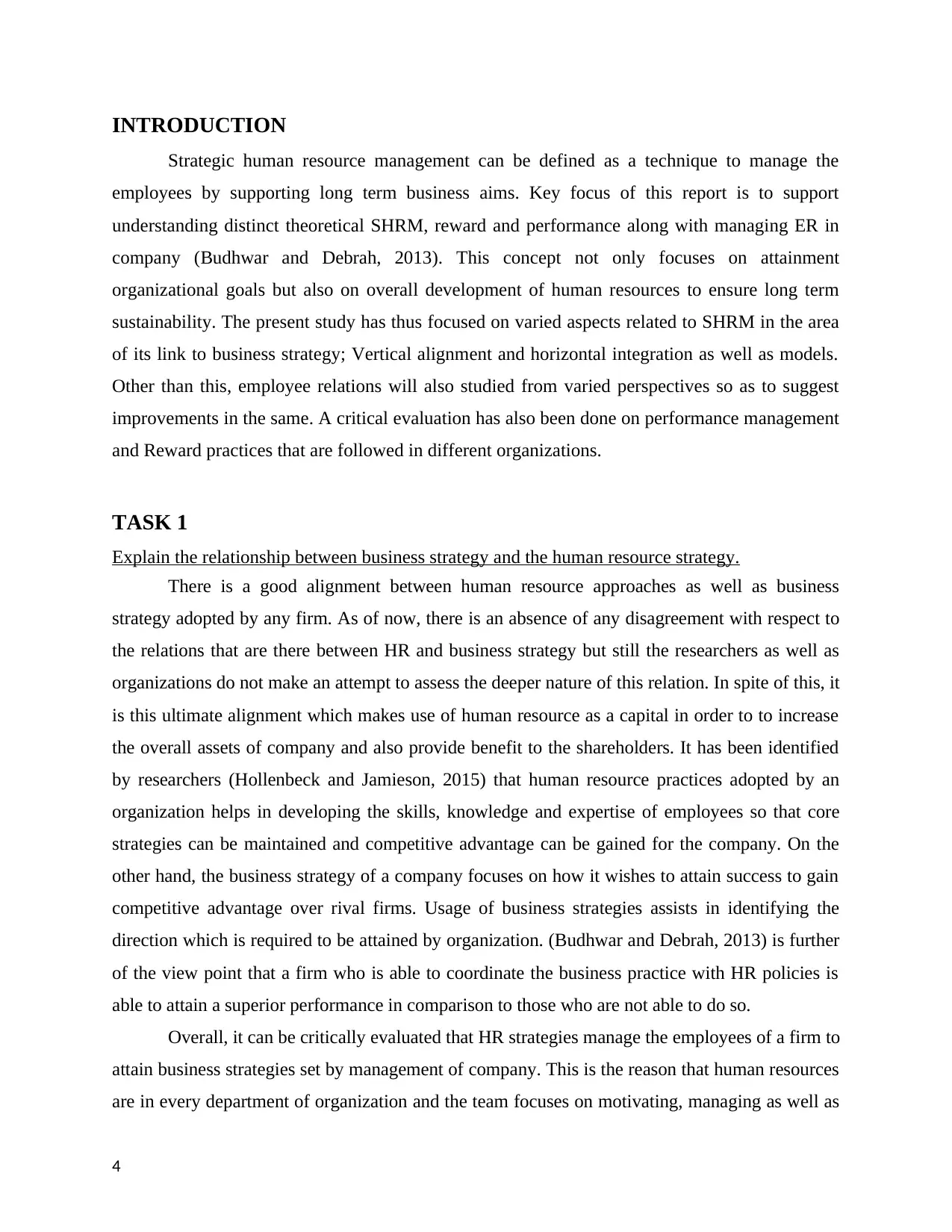
INTRODUCTION
Strategic human resource management can be defined as a technique to manage the
employees by supporting long term business aims. Key focus of this report is to support
understanding distinct theoretical SHRM, reward and performance along with managing ER in
company (Budhwar and Debrah, 2013). This concept not only focuses on attainment
organizational goals but also on overall development of human resources to ensure long term
sustainability. The present study has thus focused on varied aspects related to SHRM in the area
of its link to business strategy; Vertical alignment and horizontal integration as well as models.
Other than this, employee relations will also studied from varied perspectives so as to suggest
improvements in the same. A critical evaluation has also been done on performance management
and Reward practices that are followed in different organizations.
TASK 1
Explain the relationship between business strategy and the human resource strategy.
There is a good alignment between human resource approaches as well as business
strategy adopted by any firm. As of now, there is an absence of any disagreement with respect to
the relations that are there between HR and business strategy but still the researchers as well as
organizations do not make an attempt to assess the deeper nature of this relation. In spite of this, it
is this ultimate alignment which makes use of human resource as a capital in order to to increase
the overall assets of company and also provide benefit to the shareholders. It has been identified
by researchers (Hollenbeck and Jamieson, 2015) that human resource practices adopted by an
organization helps in developing the skills, knowledge and expertise of employees so that core
strategies can be maintained and competitive advantage can be gained for the company. On the
other hand, the business strategy of a company focuses on how it wishes to attain success to gain
competitive advantage over rival firms. Usage of business strategies assists in identifying the
direction which is required to be attained by organization. (Budhwar and Debrah, 2013) is further
of the view point that a firm who is able to coordinate the business practice with HR policies is
able to attain a superior performance in comparison to those who are not able to do so.
Overall, it can be critically evaluated that HR strategies manage the employees of a firm to
attain business strategies set by management of company. This is the reason that human resources
are in every department of organization and the team focuses on motivating, managing as well as
4
Strategic human resource management can be defined as a technique to manage the
employees by supporting long term business aims. Key focus of this report is to support
understanding distinct theoretical SHRM, reward and performance along with managing ER in
company (Budhwar and Debrah, 2013). This concept not only focuses on attainment
organizational goals but also on overall development of human resources to ensure long term
sustainability. The present study has thus focused on varied aspects related to SHRM in the area
of its link to business strategy; Vertical alignment and horizontal integration as well as models.
Other than this, employee relations will also studied from varied perspectives so as to suggest
improvements in the same. A critical evaluation has also been done on performance management
and Reward practices that are followed in different organizations.
TASK 1
Explain the relationship between business strategy and the human resource strategy.
There is a good alignment between human resource approaches as well as business
strategy adopted by any firm. As of now, there is an absence of any disagreement with respect to
the relations that are there between HR and business strategy but still the researchers as well as
organizations do not make an attempt to assess the deeper nature of this relation. In spite of this, it
is this ultimate alignment which makes use of human resource as a capital in order to to increase
the overall assets of company and also provide benefit to the shareholders. It has been identified
by researchers (Hollenbeck and Jamieson, 2015) that human resource practices adopted by an
organization helps in developing the skills, knowledge and expertise of employees so that core
strategies can be maintained and competitive advantage can be gained for the company. On the
other hand, the business strategy of a company focuses on how it wishes to attain success to gain
competitive advantage over rival firms. Usage of business strategies assists in identifying the
direction which is required to be attained by organization. (Budhwar and Debrah, 2013) is further
of the view point that a firm who is able to coordinate the business practice with HR policies is
able to attain a superior performance in comparison to those who are not able to do so.
Overall, it can be critically evaluated that HR strategies manage the employees of a firm to
attain business strategies set by management of company. This is the reason that human resources
are in every department of organization and the team focuses on motivating, managing as well as
4
Paraphrase This Document
Need a fresh take? Get an instant paraphrase of this document with our AI Paraphraser
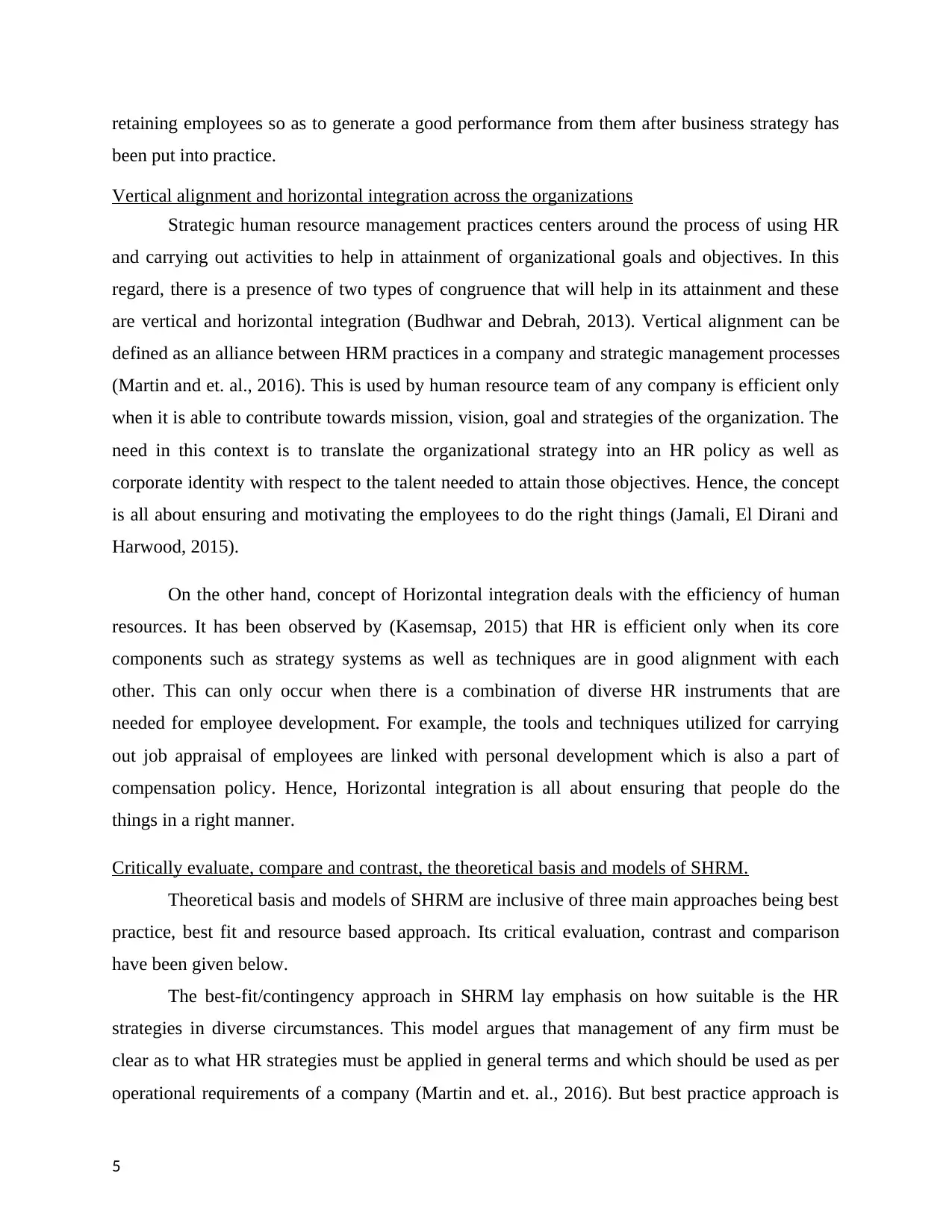
retaining employees so as to generate a good performance from them after business strategy has
been put into practice.
Vertical alignment and horizontal integration across the organizations
Strategic human resource management practices centers around the process of using HR
and carrying out activities to help in attainment of organizational goals and objectives. In this
regard, there is a presence of two types of congruence that will help in its attainment and these
are vertical and horizontal integration (Budhwar and Debrah, 2013). Vertical alignment can be
defined as an alliance between HRM practices in a company and strategic management processes
(Martin and et. al., 2016). This is used by human resource team of any company is efficient only
when it is able to contribute towards mission, vision, goal and strategies of the organization. The
need in this context is to translate the organizational strategy into an HR policy as well as
corporate identity with respect to the talent needed to attain those objectives. Hence, the concept
is all about ensuring and motivating the employees to do the right things (Jamali, El Dirani and
Harwood, 2015).
On the other hand, concept of Horizontal integration deals with the efficiency of human
resources. It has been observed by (Kasemsap, 2015) that HR is efficient only when its core
components such as strategy systems as well as techniques are in good alignment with each
other. This can only occur when there is a combination of diverse HR instruments that are
needed for employee development. For example, the tools and techniques utilized for carrying
out job appraisal of employees are linked with personal development which is also a part of
compensation policy. Hence, Horizontal integration is all about ensuring that people do the
things in a right manner.
Critically evaluate, compare and contrast, the theoretical basis and models of SHRM.
Theoretical basis and models of SHRM are inclusive of three main approaches being best
practice, best fit and resource based approach. Its critical evaluation, contrast and comparison
have been given below.
The best-fit/contingency approach in SHRM lay emphasis on how suitable is the HR
strategies in diverse circumstances. This model argues that management of any firm must be
clear as to what HR strategies must be applied in general terms and which should be used as per
operational requirements of a company (Martin and et. al., 2016). But best practice approach is
5
been put into practice.
Vertical alignment and horizontal integration across the organizations
Strategic human resource management practices centers around the process of using HR
and carrying out activities to help in attainment of organizational goals and objectives. In this
regard, there is a presence of two types of congruence that will help in its attainment and these
are vertical and horizontal integration (Budhwar and Debrah, 2013). Vertical alignment can be
defined as an alliance between HRM practices in a company and strategic management processes
(Martin and et. al., 2016). This is used by human resource team of any company is efficient only
when it is able to contribute towards mission, vision, goal and strategies of the organization. The
need in this context is to translate the organizational strategy into an HR policy as well as
corporate identity with respect to the talent needed to attain those objectives. Hence, the concept
is all about ensuring and motivating the employees to do the right things (Jamali, El Dirani and
Harwood, 2015).
On the other hand, concept of Horizontal integration deals with the efficiency of human
resources. It has been observed by (Kasemsap, 2015) that HR is efficient only when its core
components such as strategy systems as well as techniques are in good alignment with each
other. This can only occur when there is a combination of diverse HR instruments that are
needed for employee development. For example, the tools and techniques utilized for carrying
out job appraisal of employees are linked with personal development which is also a part of
compensation policy. Hence, Horizontal integration is all about ensuring that people do the
things in a right manner.
Critically evaluate, compare and contrast, the theoretical basis and models of SHRM.
Theoretical basis and models of SHRM are inclusive of three main approaches being best
practice, best fit and resource based approach. Its critical evaluation, contrast and comparison
have been given below.
The best-fit/contingency approach in SHRM lay emphasis on how suitable is the HR
strategies in diverse circumstances. This model argues that management of any firm must be
clear as to what HR strategies must be applied in general terms and which should be used as per
operational requirements of a company (Martin and et. al., 2016). But best practice approach is
5
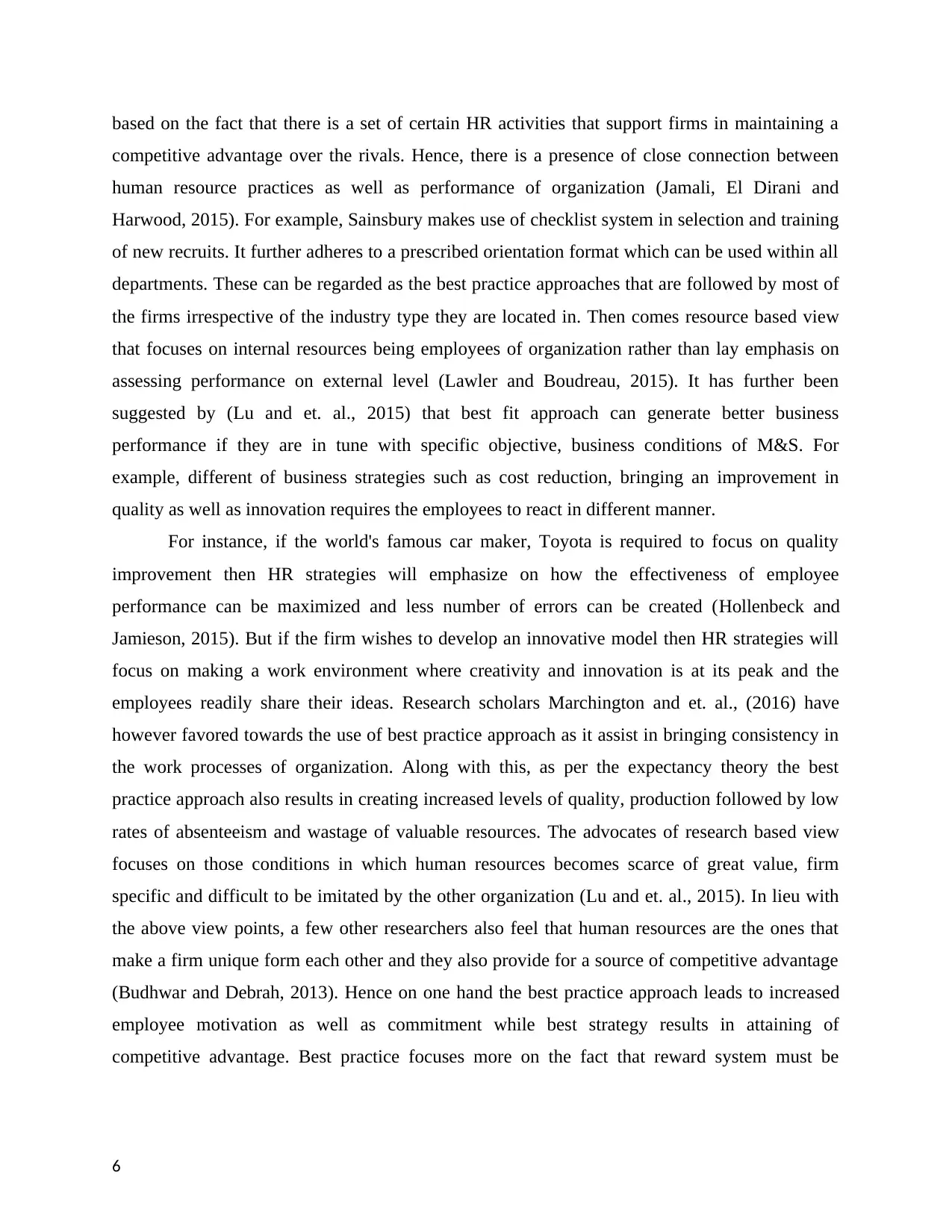
based on the fact that there is a set of certain HR activities that support firms in maintaining a
competitive advantage over the rivals. Hence, there is a presence of close connection between
human resource practices as well as performance of organization (Jamali, El Dirani and
Harwood, 2015). For example, Sainsbury makes use of checklist system in selection and training
of new recruits. It further adheres to a prescribed orientation format which can be used within all
departments. These can be regarded as the best practice approaches that are followed by most of
the firms irrespective of the industry type they are located in. Then comes resource based view
that focuses on internal resources being employees of organization rather than lay emphasis on
assessing performance on external level (Lawler and Boudreau, 2015). It has further been
suggested by (Lu and et. al., 2015) that best fit approach can generate better business
performance if they are in tune with specific objective, business conditions of M&S. For
example, different of business strategies such as cost reduction, bringing an improvement in
quality as well as innovation requires the employees to react in different manner.
For instance, if the world's famous car maker, Toyota is required to focus on quality
improvement then HR strategies will emphasize on how the effectiveness of employee
performance can be maximized and less number of errors can be created (Hollenbeck and
Jamieson, 2015). But if the firm wishes to develop an innovative model then HR strategies will
focus on making a work environment where creativity and innovation is at its peak and the
employees readily share their ideas. Research scholars Marchington and et. al., (2016) have
however favored towards the use of best practice approach as it assist in bringing consistency in
the work processes of organization. Along with this, as per the expectancy theory the best
practice approach also results in creating increased levels of quality, production followed by low
rates of absenteeism and wastage of valuable resources. The advocates of research based view
focuses on those conditions in which human resources becomes scarce of great value, firm
specific and difficult to be imitated by the other organization (Lu and et. al., 2015). In lieu with
the above view points, a few other researchers also feel that human resources are the ones that
make a firm unique form each other and they also provide for a source of competitive advantage
(Budhwar and Debrah, 2013). Hence on one hand the best practice approach leads to increased
employee motivation as well as commitment while best strategy results in attaining of
competitive advantage. Best practice focuses more on the fact that reward system must be
6
competitive advantage over the rivals. Hence, there is a presence of close connection between
human resource practices as well as performance of organization (Jamali, El Dirani and
Harwood, 2015). For example, Sainsbury makes use of checklist system in selection and training
of new recruits. It further adheres to a prescribed orientation format which can be used within all
departments. These can be regarded as the best practice approaches that are followed by most of
the firms irrespective of the industry type they are located in. Then comes resource based view
that focuses on internal resources being employees of organization rather than lay emphasis on
assessing performance on external level (Lawler and Boudreau, 2015). It has further been
suggested by (Lu and et. al., 2015) that best fit approach can generate better business
performance if they are in tune with specific objective, business conditions of M&S. For
example, different of business strategies such as cost reduction, bringing an improvement in
quality as well as innovation requires the employees to react in different manner.
For instance, if the world's famous car maker, Toyota is required to focus on quality
improvement then HR strategies will emphasize on how the effectiveness of employee
performance can be maximized and less number of errors can be created (Hollenbeck and
Jamieson, 2015). But if the firm wishes to develop an innovative model then HR strategies will
focus on making a work environment where creativity and innovation is at its peak and the
employees readily share their ideas. Research scholars Marchington and et. al., (2016) have
however favored towards the use of best practice approach as it assist in bringing consistency in
the work processes of organization. Along with this, as per the expectancy theory the best
practice approach also results in creating increased levels of quality, production followed by low
rates of absenteeism and wastage of valuable resources. The advocates of research based view
focuses on those conditions in which human resources becomes scarce of great value, firm
specific and difficult to be imitated by the other organization (Lu and et. al., 2015). In lieu with
the above view points, a few other researchers also feel that human resources are the ones that
make a firm unique form each other and they also provide for a source of competitive advantage
(Budhwar and Debrah, 2013). Hence on one hand the best practice approach leads to increased
employee motivation as well as commitment while best strategy results in attaining of
competitive advantage. Best practice focuses more on the fact that reward system must be
6
⊘ This is a preview!⊘
Do you want full access?
Subscribe today to unlock all pages.

Trusted by 1+ million students worldwide
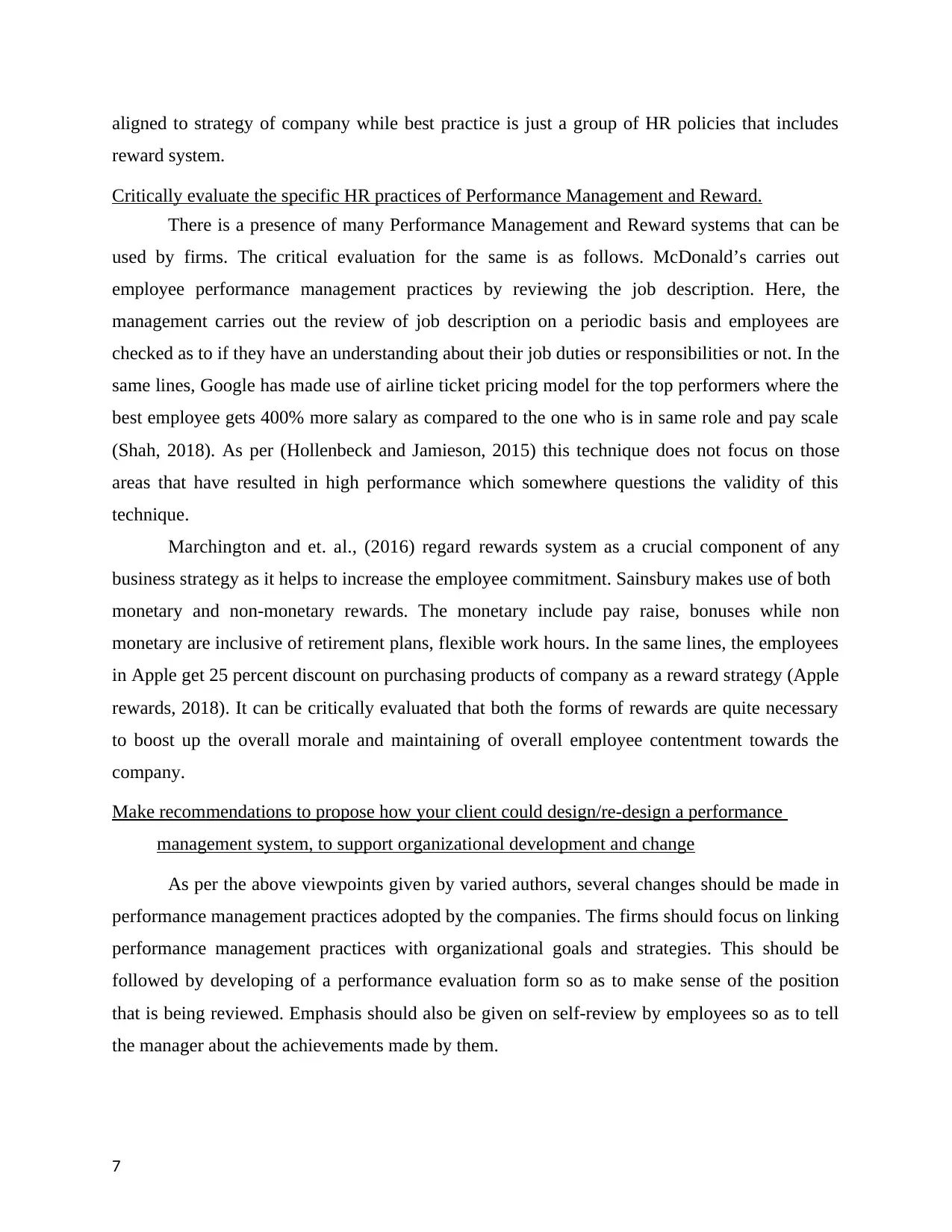
aligned to strategy of company while best practice is just a group of HR policies that includes
reward system.
Critically evaluate the specific HR practices of Performance Management and Reward.
There is a presence of many Performance Management and Reward systems that can be
used by firms. The critical evaluation for the same is as follows. McDonald’s carries out
employee performance management practices by reviewing the job description. Here, the
management carries out the review of job description on a periodic basis and employees are
checked as to if they have an understanding about their job duties or responsibilities or not. In the
same lines, Google has made use of airline ticket pricing model for the top performers where the
best employee gets 400% more salary as compared to the one who is in same role and pay scale
(Shah, 2018). As per (Hollenbeck and Jamieson, 2015) this technique does not focus on those
areas that have resulted in high performance which somewhere questions the validity of this
technique.
Marchington and et. al., (2016) regard rewards system as a crucial component of any
business strategy as it helps to increase the employee commitment. Sainsbury makes use of both
monetary and non-monetary rewards. The monetary include pay raise, bonuses while non
monetary are inclusive of retirement plans, flexible work hours. In the same lines, the employees
in Apple get 25 percent discount on purchasing products of company as a reward strategy (Apple
rewards, 2018). It can be critically evaluated that both the forms of rewards are quite necessary
to boost up the overall morale and maintaining of overall employee contentment towards the
company.
Make recommendations to propose how your client could design/re-design a performance
management system, to support organizational development and change
As per the above viewpoints given by varied authors, several changes should be made in
performance management practices adopted by the companies. The firms should focus on linking
performance management practices with organizational goals and strategies. This should be
followed by developing of a performance evaluation form so as to make sense of the position
that is being reviewed. Emphasis should also be given on self-review by employees so as to tell
the manager about the achievements made by them.
7
reward system.
Critically evaluate the specific HR practices of Performance Management and Reward.
There is a presence of many Performance Management and Reward systems that can be
used by firms. The critical evaluation for the same is as follows. McDonald’s carries out
employee performance management practices by reviewing the job description. Here, the
management carries out the review of job description on a periodic basis and employees are
checked as to if they have an understanding about their job duties or responsibilities or not. In the
same lines, Google has made use of airline ticket pricing model for the top performers where the
best employee gets 400% more salary as compared to the one who is in same role and pay scale
(Shah, 2018). As per (Hollenbeck and Jamieson, 2015) this technique does not focus on those
areas that have resulted in high performance which somewhere questions the validity of this
technique.
Marchington and et. al., (2016) regard rewards system as a crucial component of any
business strategy as it helps to increase the employee commitment. Sainsbury makes use of both
monetary and non-monetary rewards. The monetary include pay raise, bonuses while non
monetary are inclusive of retirement plans, flexible work hours. In the same lines, the employees
in Apple get 25 percent discount on purchasing products of company as a reward strategy (Apple
rewards, 2018). It can be critically evaluated that both the forms of rewards are quite necessary
to boost up the overall morale and maintaining of overall employee contentment towards the
company.
Make recommendations to propose how your client could design/re-design a performance
management system, to support organizational development and change
As per the above viewpoints given by varied authors, several changes should be made in
performance management practices adopted by the companies. The firms should focus on linking
performance management practices with organizational goals and strategies. This should be
followed by developing of a performance evaluation form so as to make sense of the position
that is being reviewed. Emphasis should also be given on self-review by employees so as to tell
the manager about the achievements made by them.
7
Paraphrase This Document
Need a fresh take? Get an instant paraphrase of this document with our AI Paraphraser
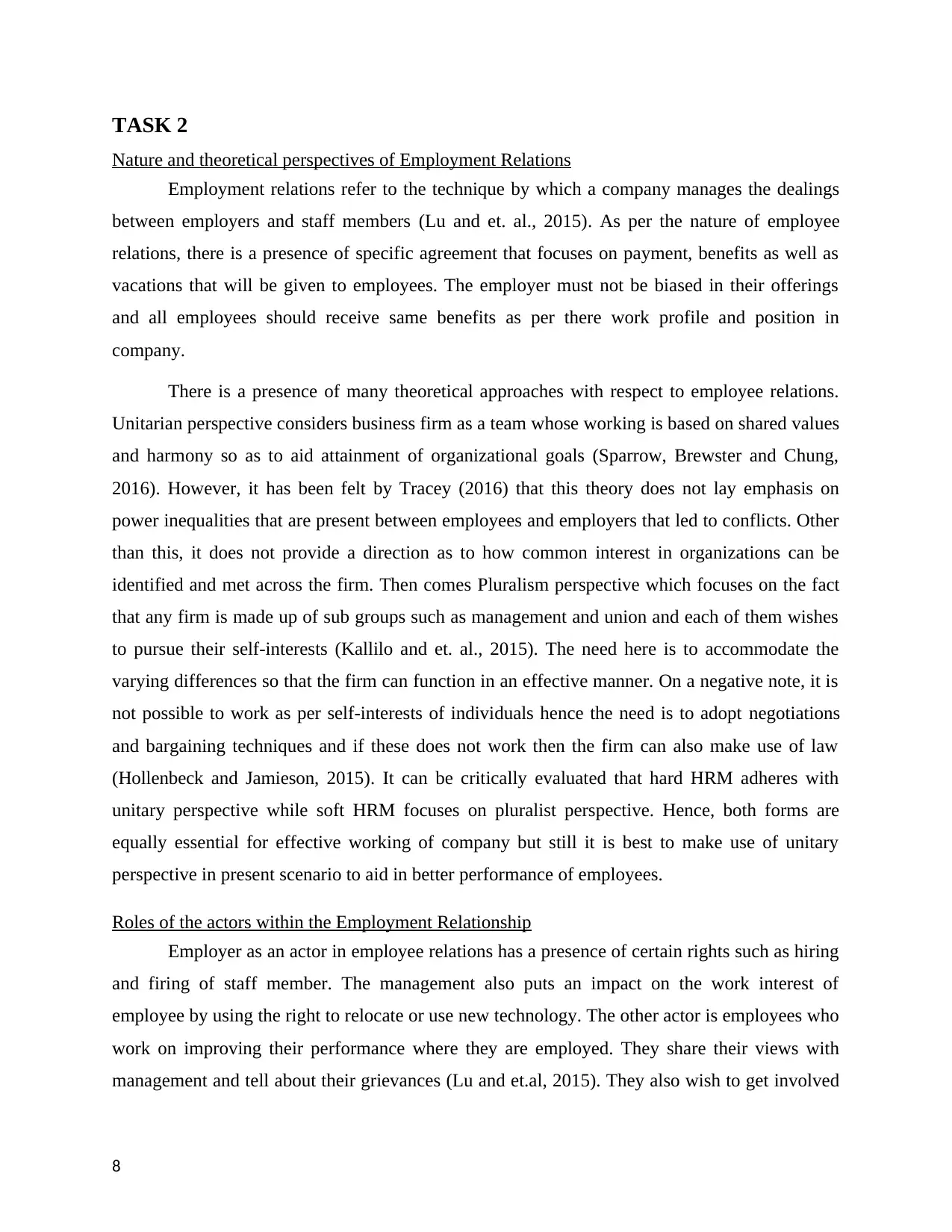
TASK 2
Nature and theoretical perspectives of Employment Relations
Employment relations refer to the technique by which a company manages the dealings
between employers and staff members (Lu and et. al., 2015). As per the nature of employee
relations, there is a presence of specific agreement that focuses on payment, benefits as well as
vacations that will be given to employees. The employer must not be biased in their offerings
and all employees should receive same benefits as per there work profile and position in
company.
There is a presence of many theoretical approaches with respect to employee relations.
Unitarian perspective considers business firm as a team whose working is based on shared values
and harmony so as to aid attainment of organizational goals (Sparrow, Brewster and Chung,
2016). However, it has been felt by Tracey (2016) that this theory does not lay emphasis on
power inequalities that are present between employees and employers that led to conflicts. Other
than this, it does not provide a direction as to how common interest in organizations can be
identified and met across the firm. Then comes Pluralism perspective which focuses on the fact
that any firm is made up of sub groups such as management and union and each of them wishes
to pursue their self-interests (Kallilo and et. al., 2015). The need here is to accommodate the
varying differences so that the firm can function in an effective manner. On a negative note, it is
not possible to work as per self-interests of individuals hence the need is to adopt negotiations
and bargaining techniques and if these does not work then the firm can also make use of law
(Hollenbeck and Jamieson, 2015). It can be critically evaluated that hard HRM adheres with
unitary perspective while soft HRM focuses on pluralist perspective. Hence, both forms are
equally essential for effective working of company but still it is best to make use of unitary
perspective in present scenario to aid in better performance of employees.
Roles of the actors within the Employment Relationship
Employer as an actor in employee relations has a presence of certain rights such as hiring
and firing of staff member. The management also puts an impact on the work interest of
employee by using the right to relocate or use new technology. The other actor is employees who
work on improving their performance where they are employed. They share their views with
management and tell about their grievances (Lu and et.al, 2015). They also wish to get involved
8
Nature and theoretical perspectives of Employment Relations
Employment relations refer to the technique by which a company manages the dealings
between employers and staff members (Lu and et. al., 2015). As per the nature of employee
relations, there is a presence of specific agreement that focuses on payment, benefits as well as
vacations that will be given to employees. The employer must not be biased in their offerings
and all employees should receive same benefits as per there work profile and position in
company.
There is a presence of many theoretical approaches with respect to employee relations.
Unitarian perspective considers business firm as a team whose working is based on shared values
and harmony so as to aid attainment of organizational goals (Sparrow, Brewster and Chung,
2016). However, it has been felt by Tracey (2016) that this theory does not lay emphasis on
power inequalities that are present between employees and employers that led to conflicts. Other
than this, it does not provide a direction as to how common interest in organizations can be
identified and met across the firm. Then comes Pluralism perspective which focuses on the fact
that any firm is made up of sub groups such as management and union and each of them wishes
to pursue their self-interests (Kallilo and et. al., 2015). The need here is to accommodate the
varying differences so that the firm can function in an effective manner. On a negative note, it is
not possible to work as per self-interests of individuals hence the need is to adopt negotiations
and bargaining techniques and if these does not work then the firm can also make use of law
(Hollenbeck and Jamieson, 2015). It can be critically evaluated that hard HRM adheres with
unitary perspective while soft HRM focuses on pluralist perspective. Hence, both forms are
equally essential for effective working of company but still it is best to make use of unitary
perspective in present scenario to aid in better performance of employees.
Roles of the actors within the Employment Relationship
Employer as an actor in employee relations has a presence of certain rights such as hiring
and firing of staff member. The management also puts an impact on the work interest of
employee by using the right to relocate or use new technology. The other actor is employees who
work on improving their performance where they are employed. They share their views with
management and tell about their grievances (Lu and et.al, 2015). They also wish to get involved
8
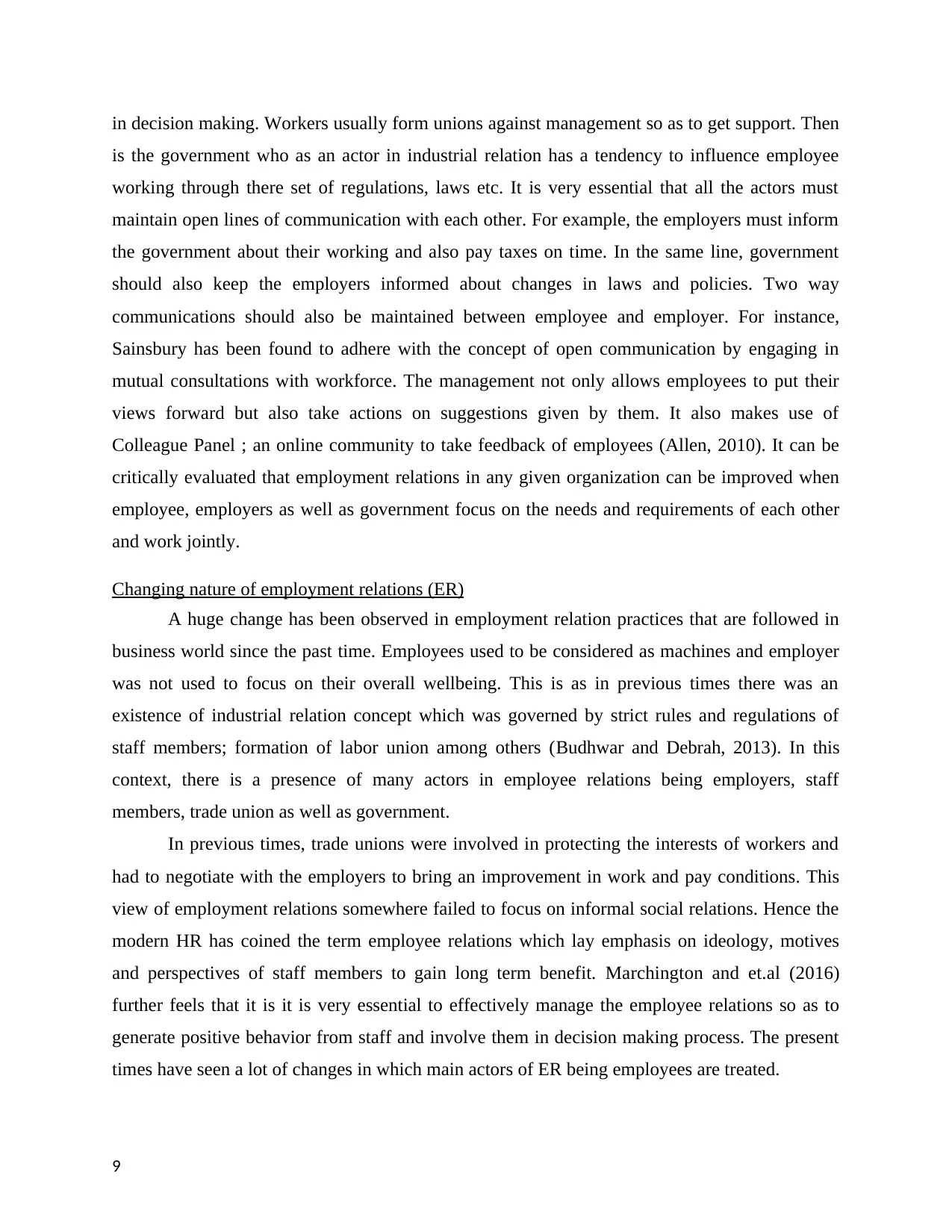
in decision making. Workers usually form unions against management so as to get support. Then
is the government who as an actor in industrial relation has a tendency to influence employee
working through there set of regulations, laws etc. It is very essential that all the actors must
maintain open lines of communication with each other. For example, the employers must inform
the government about their working and also pay taxes on time. In the same line, government
should also keep the employers informed about changes in laws and policies. Two way
communications should also be maintained between employee and employer. For instance,
Sainsbury has been found to adhere with the concept of open communication by engaging in
mutual consultations with workforce. The management not only allows employees to put their
views forward but also take actions on suggestions given by them. It also makes use of
Colleague Panel ; an online community to take feedback of employees (Allen, 2010). It can be
critically evaluated that employment relations in any given organization can be improved when
employee, employers as well as government focus on the needs and requirements of each other
and work jointly.
Changing nature of employment relations (ER)
A huge change has been observed in employment relation practices that are followed in
business world since the past time. Employees used to be considered as machines and employer
was not used to focus on their overall wellbeing. This is as in previous times there was an
existence of industrial relation concept which was governed by strict rules and regulations of
staff members; formation of labor union among others (Budhwar and Debrah, 2013). In this
context, there is a presence of many actors in employee relations being employers, staff
members, trade union as well as government.
In previous times, trade unions were involved in protecting the interests of workers and
had to negotiate with the employers to bring an improvement in work and pay conditions. This
view of employment relations somewhere failed to focus on informal social relations. Hence the
modern HR has coined the term employee relations which lay emphasis on ideology, motives
and perspectives of staff members to gain long term benefit. Marchington and et.al (2016)
further feels that it is it is very essential to effectively manage the employee relations so as to
generate positive behavior from staff and involve them in decision making process. The present
times have seen a lot of changes in which main actors of ER being employees are treated.
9
is the government who as an actor in industrial relation has a tendency to influence employee
working through there set of regulations, laws etc. It is very essential that all the actors must
maintain open lines of communication with each other. For example, the employers must inform
the government about their working and also pay taxes on time. In the same line, government
should also keep the employers informed about changes in laws and policies. Two way
communications should also be maintained between employee and employer. For instance,
Sainsbury has been found to adhere with the concept of open communication by engaging in
mutual consultations with workforce. The management not only allows employees to put their
views forward but also take actions on suggestions given by them. It also makes use of
Colleague Panel ; an online community to take feedback of employees (Allen, 2010). It can be
critically evaluated that employment relations in any given organization can be improved when
employee, employers as well as government focus on the needs and requirements of each other
and work jointly.
Changing nature of employment relations (ER)
A huge change has been observed in employment relation practices that are followed in
business world since the past time. Employees used to be considered as machines and employer
was not used to focus on their overall wellbeing. This is as in previous times there was an
existence of industrial relation concept which was governed by strict rules and regulations of
staff members; formation of labor union among others (Budhwar and Debrah, 2013). In this
context, there is a presence of many actors in employee relations being employers, staff
members, trade union as well as government.
In previous times, trade unions were involved in protecting the interests of workers and
had to negotiate with the employers to bring an improvement in work and pay conditions. This
view of employment relations somewhere failed to focus on informal social relations. Hence the
modern HR has coined the term employee relations which lay emphasis on ideology, motives
and perspectives of staff members to gain long term benefit. Marchington and et.al (2016)
further feels that it is it is very essential to effectively manage the employee relations so as to
generate positive behavior from staff and involve them in decision making process. The present
times have seen a lot of changes in which main actors of ER being employees are treated.
9
⊘ This is a preview!⊘
Do you want full access?
Subscribe today to unlock all pages.

Trusted by 1+ million students worldwide
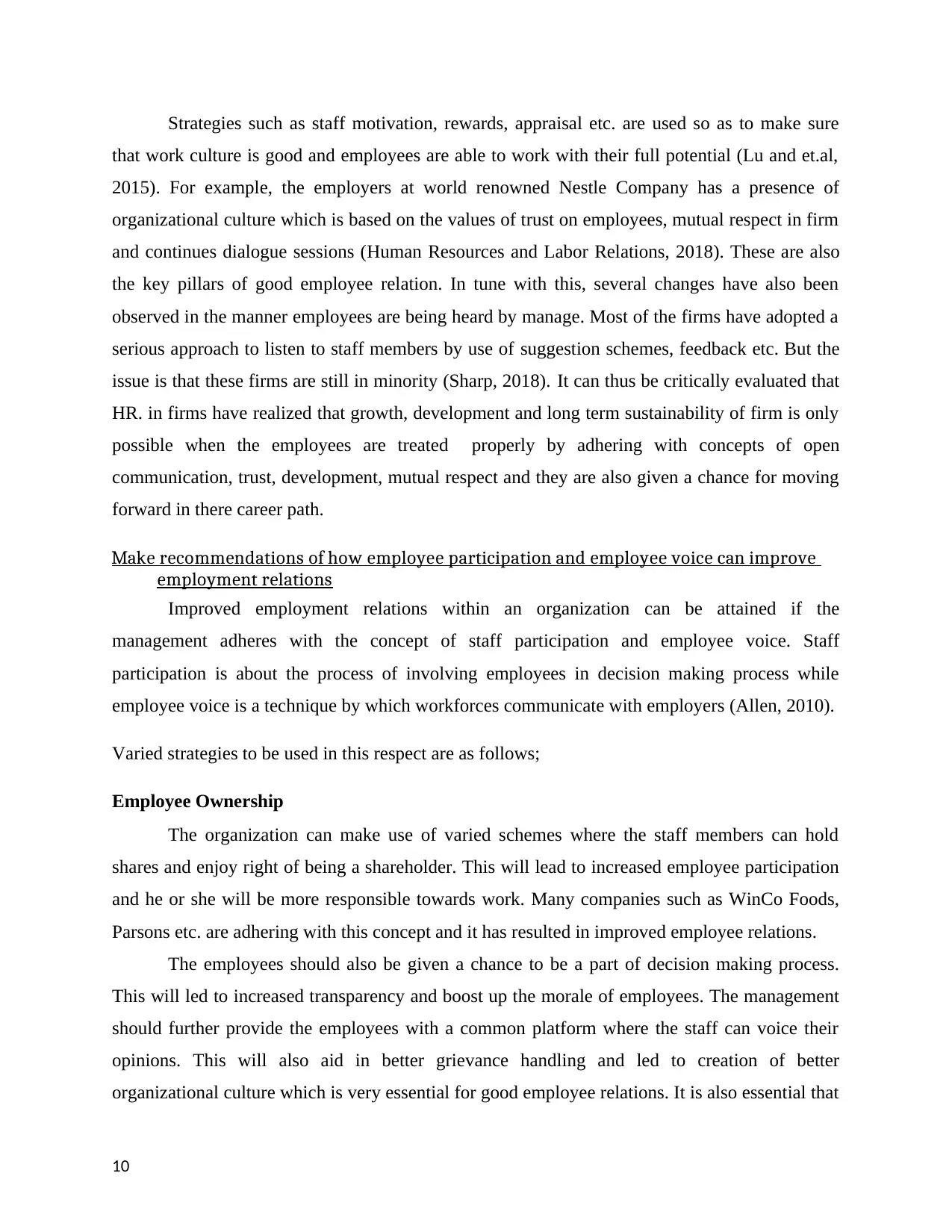
Strategies such as staff motivation, rewards, appraisal etc. are used so as to make sure
that work culture is good and employees are able to work with their full potential (Lu and et.al,
2015). For example, the employers at world renowned Nestle Company has a presence of
organizational culture which is based on the values of trust on employees, mutual respect in firm
and continues dialogue sessions (Human Resources and Labor Relations, 2018). These are also
the key pillars of good employee relation. In tune with this, several changes have also been
observed in the manner employees are being heard by manage. Most of the firms have adopted a
serious approach to listen to staff members by use of suggestion schemes, feedback etc. But the
issue is that these firms are still in minority (Sharp, 2018). It can thus be critically evaluated that
HR. in firms have realized that growth, development and long term sustainability of firm is only
possible when the employees are treated properly by adhering with concepts of open
communication, trust, development, mutual respect and they are also given a chance for moving
forward in there career path.
Make recommendations of how employee participation and employee voice can improve
employment relations
Improved employment relations within an organization can be attained if the
management adheres with the concept of staff participation and employee voice. Staff
participation is about the process of involving employees in decision making process while
employee voice is a technique by which workforces communicate with employers (Allen, 2010).
Varied strategies to be used in this respect are as follows;
Employee Ownership
The organization can make use of varied schemes where the staff members can hold
shares and enjoy right of being a shareholder. This will lead to increased employee participation
and he or she will be more responsible towards work. Many companies such as WinCo Foods,
Parsons etc. are adhering with this concept and it has resulted in improved employee relations.
The employees should also be given a chance to be a part of decision making process.
This will led to increased transparency and boost up the morale of employees. The management
should further provide the employees with a common platform where the staff can voice their
opinions. This will also aid in better grievance handling and led to creation of better
organizational culture which is very essential for good employee relations. It is also essential that
10
that work culture is good and employees are able to work with their full potential (Lu and et.al,
2015). For example, the employers at world renowned Nestle Company has a presence of
organizational culture which is based on the values of trust on employees, mutual respect in firm
and continues dialogue sessions (Human Resources and Labor Relations, 2018). These are also
the key pillars of good employee relation. In tune with this, several changes have also been
observed in the manner employees are being heard by manage. Most of the firms have adopted a
serious approach to listen to staff members by use of suggestion schemes, feedback etc. But the
issue is that these firms are still in minority (Sharp, 2018). It can thus be critically evaluated that
HR. in firms have realized that growth, development and long term sustainability of firm is only
possible when the employees are treated properly by adhering with concepts of open
communication, trust, development, mutual respect and they are also given a chance for moving
forward in there career path.
Make recommendations of how employee participation and employee voice can improve
employment relations
Improved employment relations within an organization can be attained if the
management adheres with the concept of staff participation and employee voice. Staff
participation is about the process of involving employees in decision making process while
employee voice is a technique by which workforces communicate with employers (Allen, 2010).
Varied strategies to be used in this respect are as follows;
Employee Ownership
The organization can make use of varied schemes where the staff members can hold
shares and enjoy right of being a shareholder. This will lead to increased employee participation
and he or she will be more responsible towards work. Many companies such as WinCo Foods,
Parsons etc. are adhering with this concept and it has resulted in improved employee relations.
The employees should also be given a chance to be a part of decision making process.
This will led to increased transparency and boost up the morale of employees. The management
should further provide the employees with a common platform where the staff can voice their
opinions. This will also aid in better grievance handling and led to creation of better
organizational culture which is very essential for good employee relations. It is also essential that
10
Paraphrase This Document
Need a fresh take? Get an instant paraphrase of this document with our AI Paraphraser
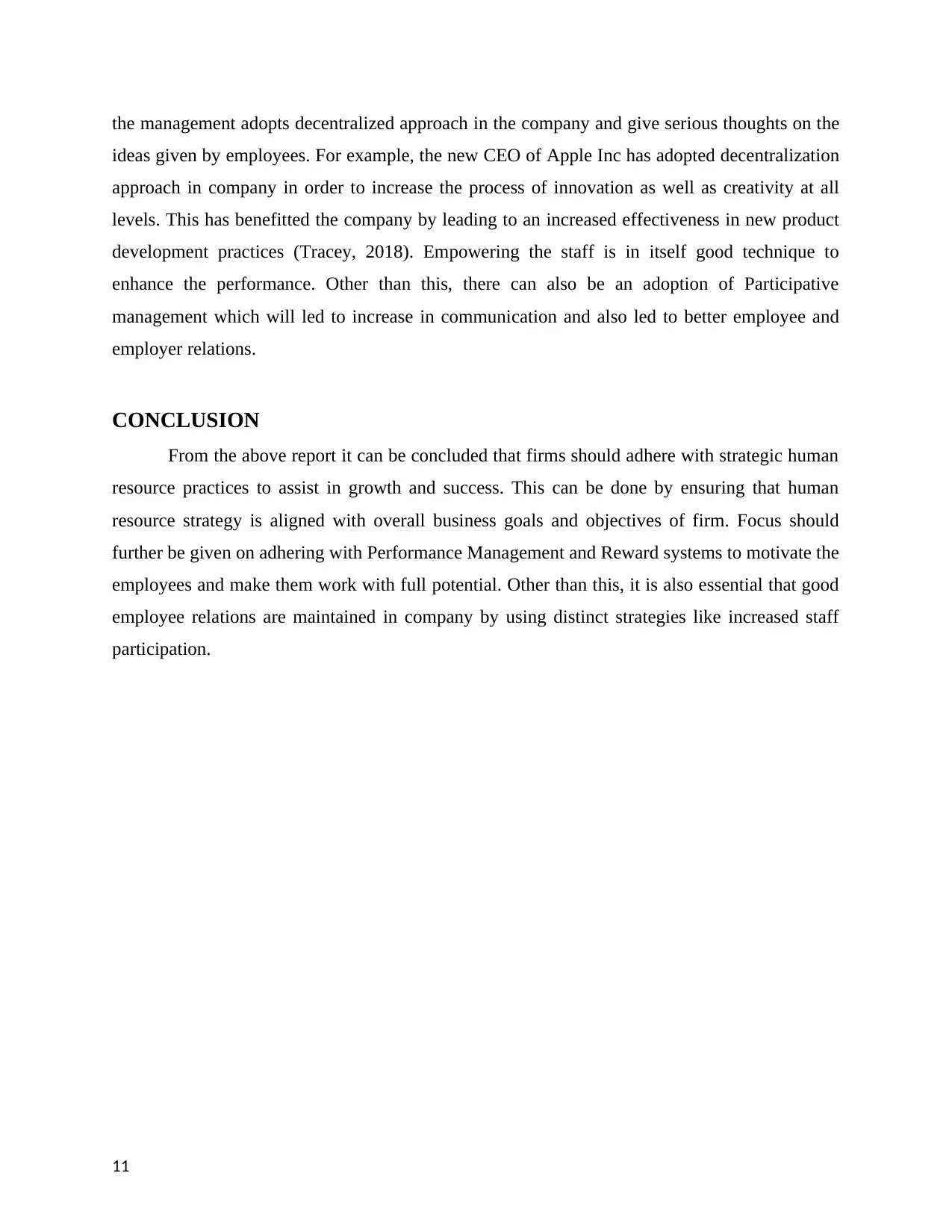
the management adopts decentralized approach in the company and give serious thoughts on the
ideas given by employees. For example, the new CEO of Apple Inc has adopted decentralization
approach in company in order to increase the process of innovation as well as creativity at all
levels. This has benefitted the company by leading to an increased effectiveness in new product
development practices (Tracey, 2018). Empowering the staff is in itself good technique to
enhance the performance. Other than this, there can also be an adoption of Participative
management which will led to increase in communication and also led to better employee and
employer relations.
CONCLUSION
From the above report it can be concluded that firms should adhere with strategic human
resource practices to assist in growth and success. This can be done by ensuring that human
resource strategy is aligned with overall business goals and objectives of firm. Focus should
further be given on adhering with Performance Management and Reward systems to motivate the
employees and make them work with full potential. Other than this, it is also essential that good
employee relations are maintained in company by using distinct strategies like increased staff
participation.
11
ideas given by employees. For example, the new CEO of Apple Inc has adopted decentralization
approach in company in order to increase the process of innovation as well as creativity at all
levels. This has benefitted the company by leading to an increased effectiveness in new product
development practices (Tracey, 2018). Empowering the staff is in itself good technique to
enhance the performance. Other than this, there can also be an adoption of Participative
management which will led to increase in communication and also led to better employee and
employer relations.
CONCLUSION
From the above report it can be concluded that firms should adhere with strategic human
resource practices to assist in growth and success. This can be done by ensuring that human
resource strategy is aligned with overall business goals and objectives of firm. Focus should
further be given on adhering with Performance Management and Reward systems to motivate the
employees and make them work with full potential. Other than this, it is also essential that good
employee relations are maintained in company by using distinct strategies like increased staff
participation.
11
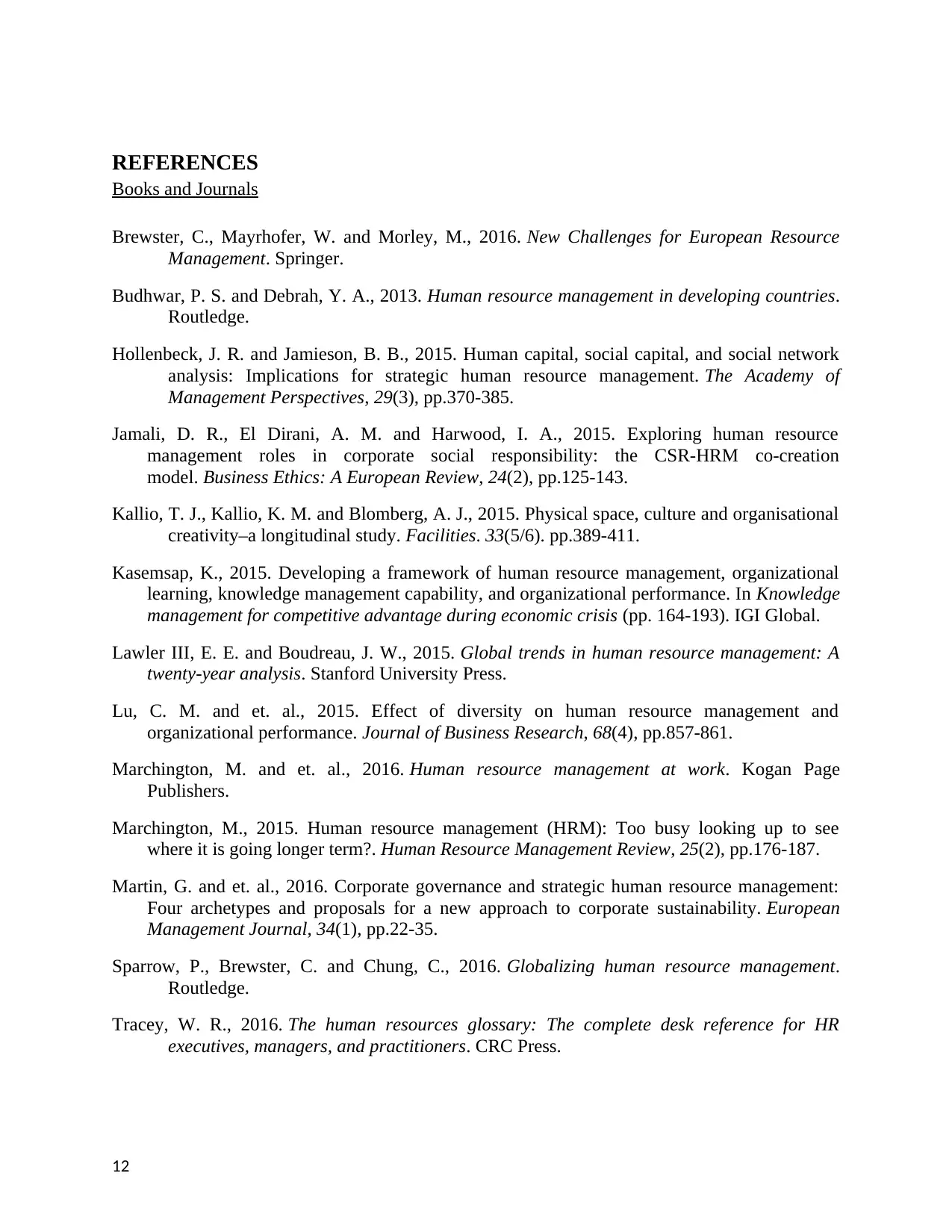
REFERENCES
Books and Journals
Brewster, C., Mayrhofer, W. and Morley, M., 2016. New Challenges for European Resource
Management. Springer.
Budhwar, P. S. and Debrah, Y. A., 2013. Human resource management in developing countries.
Routledge.
Hollenbeck, J. R. and Jamieson, B. B., 2015. Human capital, social capital, and social network
analysis: Implications for strategic human resource management. The Academy of
Management Perspectives, 29(3), pp.370-385.
Jamali, D. R., El Dirani, A. M. and Harwood, I. A., 2015. Exploring human resource
management roles in corporate social responsibility: the CSR‐HRM co‐creation
model. Business Ethics: A European Review, 24(2), pp.125-143.
Kallio, T. J., Kallio, K. M. and Blomberg, A. J., 2015. Physical space, culture and organisational
creativity–a longitudinal study. Facilities. 33(5/6). pp.389-411.
Kasemsap, K., 2015. Developing a framework of human resource management, organizational
learning, knowledge management capability, and organizational performance. In Knowledge
management for competitive advantage during economic crisis (pp. 164-193). IGI Global.
Lawler III, E. E. and Boudreau, J. W., 2015. Global trends in human resource management: A
twenty-year analysis. Stanford University Press.
Lu, C. M. and et. al., 2015. Effect of diversity on human resource management and
organizational performance. Journal of Business Research, 68(4), pp.857-861.
Marchington, M. and et. al., 2016. Human resource management at work. Kogan Page
Publishers.
Marchington, M., 2015. Human resource management (HRM): Too busy looking up to see
where it is going longer term?. Human Resource Management Review, 25(2), pp.176-187.
Martin, G. and et. al., 2016. Corporate governance and strategic human resource management:
Four archetypes and proposals for a new approach to corporate sustainability. European
Management Journal, 34(1), pp.22-35.
Sparrow, P., Brewster, C. and Chung, C., 2016. Globalizing human resource management.
Routledge.
Tracey, W. R., 2016. The human resources glossary: The complete desk reference for HR
executives, managers, and practitioners. CRC Press.
12
Books and Journals
Brewster, C., Mayrhofer, W. and Morley, M., 2016. New Challenges for European Resource
Management. Springer.
Budhwar, P. S. and Debrah, Y. A., 2013. Human resource management in developing countries.
Routledge.
Hollenbeck, J. R. and Jamieson, B. B., 2015. Human capital, social capital, and social network
analysis: Implications for strategic human resource management. The Academy of
Management Perspectives, 29(3), pp.370-385.
Jamali, D. R., El Dirani, A. M. and Harwood, I. A., 2015. Exploring human resource
management roles in corporate social responsibility: the CSR‐HRM co‐creation
model. Business Ethics: A European Review, 24(2), pp.125-143.
Kallio, T. J., Kallio, K. M. and Blomberg, A. J., 2015. Physical space, culture and organisational
creativity–a longitudinal study. Facilities. 33(5/6). pp.389-411.
Kasemsap, K., 2015. Developing a framework of human resource management, organizational
learning, knowledge management capability, and organizational performance. In Knowledge
management for competitive advantage during economic crisis (pp. 164-193). IGI Global.
Lawler III, E. E. and Boudreau, J. W., 2015. Global trends in human resource management: A
twenty-year analysis. Stanford University Press.
Lu, C. M. and et. al., 2015. Effect of diversity on human resource management and
organizational performance. Journal of Business Research, 68(4), pp.857-861.
Marchington, M. and et. al., 2016. Human resource management at work. Kogan Page
Publishers.
Marchington, M., 2015. Human resource management (HRM): Too busy looking up to see
where it is going longer term?. Human Resource Management Review, 25(2), pp.176-187.
Martin, G. and et. al., 2016. Corporate governance and strategic human resource management:
Four archetypes and proposals for a new approach to corporate sustainability. European
Management Journal, 34(1), pp.22-35.
Sparrow, P., Brewster, C. and Chung, C., 2016. Globalizing human resource management.
Routledge.
Tracey, W. R., 2016. The human resources glossary: The complete desk reference for HR
executives, managers, and practitioners. CRC Press.
12
⊘ This is a preview!⊘
Do you want full access?
Subscribe today to unlock all pages.

Trusted by 1+ million students worldwide
1 out of 13
Related Documents
Your All-in-One AI-Powered Toolkit for Academic Success.
+13062052269
info@desklib.com
Available 24*7 on WhatsApp / Email
![[object Object]](/_next/static/media/star-bottom.7253800d.svg)
Unlock your academic potential
Copyright © 2020–2025 A2Z Services. All Rights Reserved. Developed and managed by ZUCOL.





